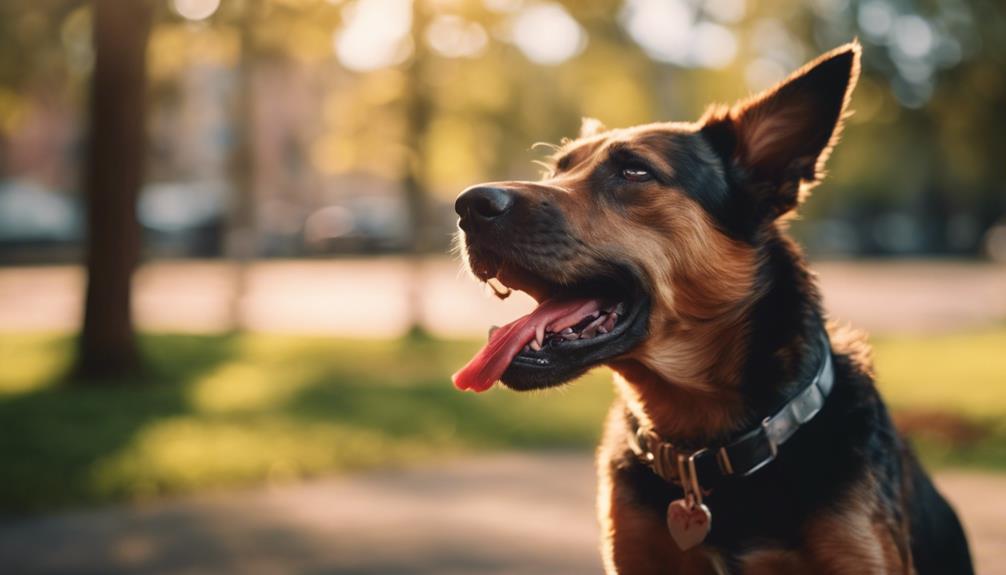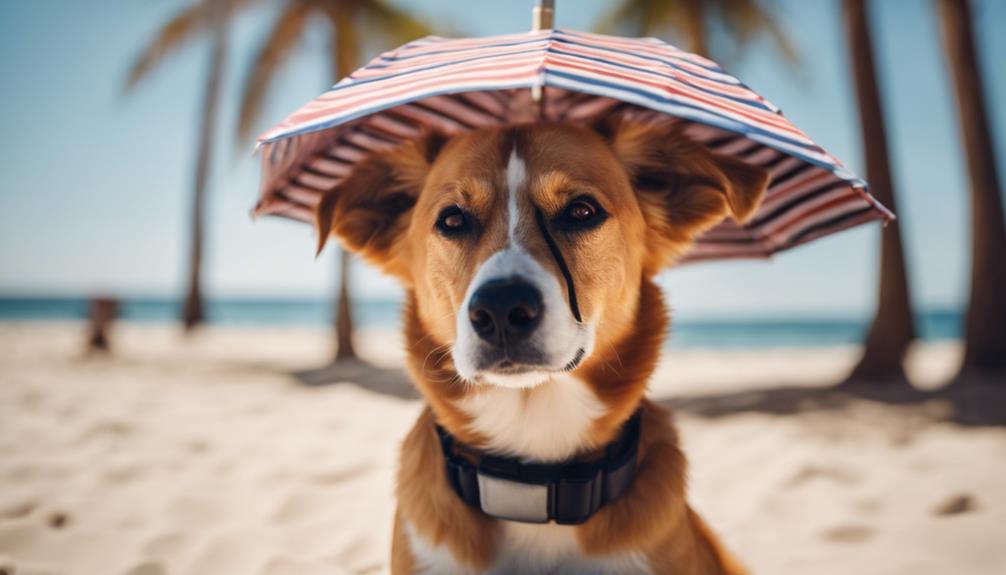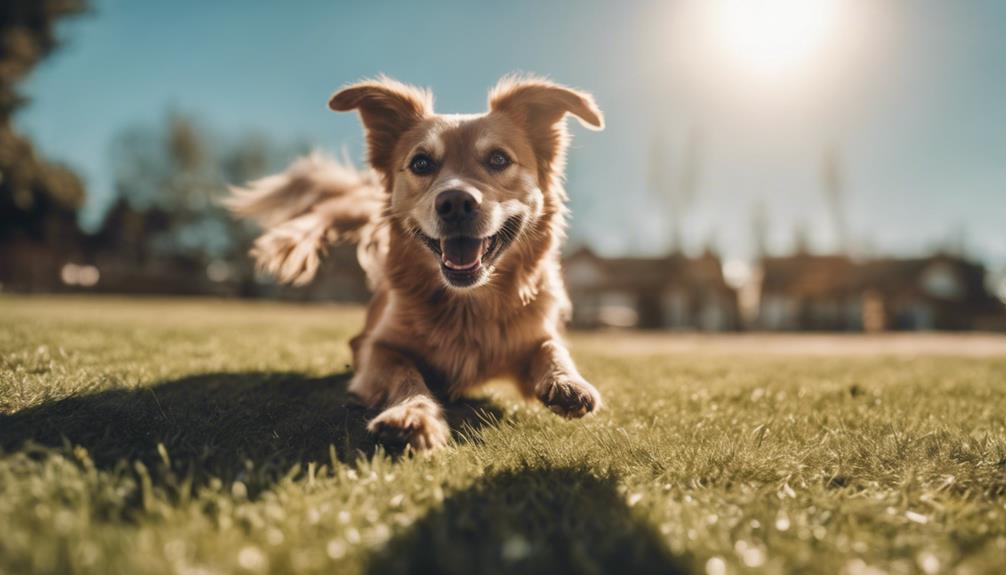When it comes to our canine companions, ensuring their well-being extends beyond regular walks and a balanced diet.
The susceptibility of dogs to sunburn is often underestimated, leading to potential health concerns that merit attention.
Understanding the intricacies of how sunlight affects dogs' skin is crucial in safeguarding their overall health.
By exploring the nuances of canine sunburn, uncovering protective measures, and shedding light on effective prevention strategies, a deeper insight into this often overlooked aspect of pet care emerges.
Key Takeaways
- All dog breeds can get sunburned, especially those with lighter hair and fair skin.
- Sunburn can occur in as little as 30-60 minutes of sun exposure.
- Protect dogs by avoiding peak sun hours, providing shade, and using dog sunscreen.
- Consult a vet for sunburn treatment, using aloe vera or cool compresses for relief.
Risk Factors for Dog Sunburns
The risk factors for dog sunburns encompass various elements that can make certain canine companions more susceptible to sun damage than others. Factors such as breed characteristics play a significant role in determining a dog's vulnerability to sunburn. Light-colored, white, hairless, or short-haired breeds like Dalmatians, Boxers, Chinese Crested, Xoloitzcuintlis, and specific Poodles are particularly at risk due to their lighter pigmentation and less hair coverage.
Additionally, dogs with recent haircuts or those residing in high-altitude areas are more prone to sunburn. Understanding these risk factors is crucial in taking proactive measures to protect dogs from harmful UV rays. By recognizing these factors, pet owners can better safeguard their furry companions from the potential dangers of sun exposure.
Common Areas Affected by Sunburn
Frequently overlooked areas prone to sunburn in dogs include their ears, eyes, noses, and bellies. When protecting your pup from harmful UV rays, it's essential to pay attention to these vulnerable areas. To ensure comprehensive sun protection for your furry friend, focus on safeguarding the following common areas:
- Ears: The thin and sparsely haired skin on a dog's ears is highly susceptible to sunburn.
- Eyes: The sensitive skin around a dog's eyes can easily get sunburned, leading to discomfort.
- Noses: Dogs with pink or light-colored noses are at risk of sunburn, which can cause pain and peeling.
- Bellies: The less hairy and often exposed belly area is prone to sunburn, especially in dogs who love belly rubs.
Signs of Sunburn in Dogs

When safeguarding your pup from the sun, recognizing the signs of sunburn in dogs is crucial for prompt intervention and care. Signs of sunburn in dogs may include red or pink skin, especially in sensitive areas like the ears, nose, belly, and groin.
Additionally, dogs with sunburn may display signs of discomfort, such as excessive itching, licking, or sensitivity to touch. It's essential to monitor your dog for any changes in skin color or texture, as well as signs of pain or irritation.
If you suspect your dog has sunburn, consult with a veterinarian for proper assessment and guidance on appropriate treatment options to alleviate your furry friend's discomfort and prevent further skin damage.
Treatment Options for Dog Sunburn
Treatment options for dog sunburn may include soothing topical applications to alleviate discomfort and promote skin healing. Here are four effective ways to treat dog sunburn:
- Aloe Vera Gel: Apply a thin layer of aloe vera gel to the affected areas to soothe the skin and reduce inflammation.
- Witch Hazel: Use witch hazel as a natural astringent to help cool and calm the sunburned skin.
- Coconut Oil: Gently massage coconut oil onto the sunburned areas to moisturize and promote healing.
- Cool Compresses: Apply cool compresses to the sunburned skin to provide instant relief and reduce redness and swelling.
Remember to consult with a veterinarian before using any treatment to ensure it is safe and appropriate for your dog's specific needs.
Preventive Measures Against Sunburn

To protect dogs from sunburn, implementing preventive measures is essential to ensure their skin health and well-being. Limiting sun exposure during peak hours, from 10 a.m. to 4 p.m., keeping dogs in the shade, providing access to water, and reducing outdoor activities in extreme heat are crucial steps.
Investing in dog-specific sunscreen, as recommended by a veterinarian, can offer added protection. Additionally, considering protective clothing for dogs that dislike sunscreen can help shield them from harmful UV rays.
It is important to prioritize the well-being of all dogs, particularly those susceptible to sunburn due to their lighter coloration or shorter hair, by taking proactive steps to prevent sun damage and maintain their skin health.
Time and Environment Considerations
Considering the impact of sun exposure on dogs, understanding the importance of time and environmental factors is crucial in safeguarding their skin health and overall well-being. When it comes to protecting your pup from sunburn, here are four essential time and environment considerations to keep in mind:
- Peak Sun Hours: Avoid letting your dog out during the peak sun hours of 10 a.m. to 4 p.m. when the sun's rays are strongest.
- Shade and Water: Keep your dog in the shade and ensure they have access to water to stay hydrated and cool.
- Limit Outdoor Activities: In extreme heat, limit your dog's outdoor activities and consider moving indoors if necessary.
- Protective Clothing: Consider using protective clothing if your dog dislikes sunscreen to shield them from harmful UV rays.
Using Dog Sunscreen Effectively

When safeguarding your dog's skin health from sun exposure, utilizing dog sunscreen effectively is paramount for their protection. Dog sunscreen is specifically formulated to suit their skin and prevent sunburn. Consulting with a veterinarian to select the appropriate sunscreen for your dog's needs is crucial. Avoid using human sunscreen as it may contain harmful ingredients for dogs. If your furry friend dislikes sunscreen application, consider using protective clothing to shield them from the sun. Ensure that the sunscreen or clothing covers vulnerable areas like the face, ears, and belly. Below is a table summarizing key points on using dog sunscreen effectively:
| Aspect | Description | Tips |
|---|---|---|
| Choose the Right Product | Consult a veterinarian for recommendations | Look for SPF 15 or higher |
| Application | Apply evenly and generously | Reapply every 2 hours |
| Sensitive Areas | Protect face, ears, belly, and nose | Use pet-safe sunscreen products |
| Sunscreen Removal | Use mild pet-friendly shampoo for cleanup | Check for any signs of irritation |
| Adverse Reactions | Watch for signs of skin irritation or allergies | Seek veterinary advice if concerns arise |
Alternative Sun Protection Methods
Exploring additional approaches to safeguarding your dog from sun exposure involves considering alternative sun protection methods beyond traditional sunscreen application. Here are four alternative methods to protect your pup's skin from harmful UV rays:
- Protective Clothing: Consider using lightweight clothing like UV-blocking shirts, hats, or sunglasses specifically designed for dogs to shield their skin from direct sunlight.
- Shade Structures: Set up shaded areas in your yard or bring along portable shade options like umbrellas or pop-up tents when out with your dog to provide relief from the sun.
- Avoid Peak Hours: Plan your outdoor activities with your dog during early mornings or late afternoons to minimize sun exposure during peak hours when the sun's rays are strongest.
- Hydration: Ensure your dog stays well-hydrated to support their overall skin health and regulate body temperature during sunny days.
Importance of Sun Protection for Dogs

Sun protection for dogs is crucial to safeguard their skin health against sun exposure. Just like humans, dogs can suffer from sunburns, leading to discomfort and health issues. Breeds with lighter or thinner coats are more vulnerable to sun damage. Using sunscreen made for dogs, suggested by veterinarians, offers extra protection. Limiting sun exposure during peak hours, ensuring shade and water, and using protective clothing if necessary are vital. Prioritizing sun protection is key to keeping dogs' skin healthy and free from sun-related ailments.
These measures are essential for maintaining the overall wellbeing of our canine companions.
Conclusion
In conclusion, it is crucial for dog owners to be aware of the risks of sunburn in dogs and take proactive measures to protect their pets' skin health.
By recognizing the common signs of sunburn, implementing preventive strategies, and utilizing effective sun protection methods such as sunscreen and clothing, dog owners can safeguard their canine companions from potential harm.
Prioritizing sun protection for dogs is essential for promoting their overall well-being and preventing skin damage.




